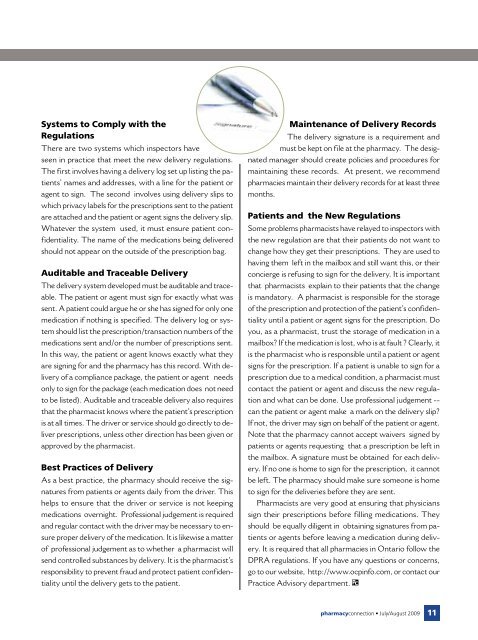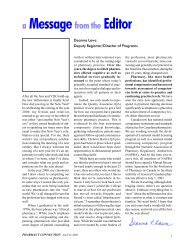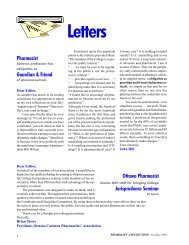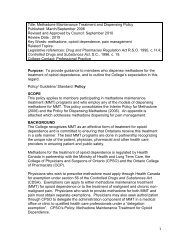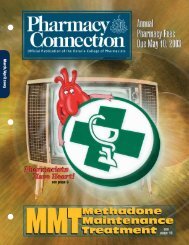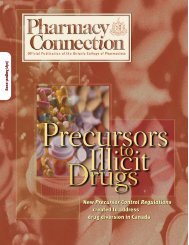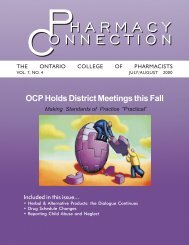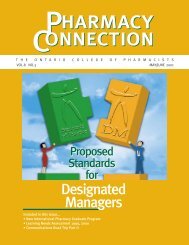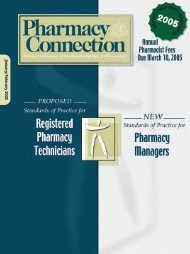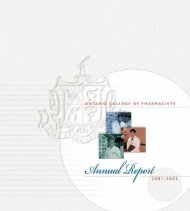Understand the Culture in Which You Practise Hyperthermia: Are ...
Understand the Culture in Which You Practise Hyperthermia: Are ...
Understand the Culture in Which You Practise Hyperthermia: Are ...
You also want an ePaper? Increase the reach of your titles
YUMPU automatically turns print PDFs into web optimized ePapers that Google loves.
Systems to Comply with <strong>the</strong><br />
Regulations<br />
There are two systems which <strong>in</strong>spectors have<br />
seen <strong>in</strong> practice that meet <strong>the</strong> new delivery regulations.<br />
The first <strong>in</strong>volves hav<strong>in</strong>g a delivery log set up list<strong>in</strong>g <strong>the</strong> patients’<br />
names and addresses, with a l<strong>in</strong>e for <strong>the</strong> patient or<br />
agent to sign. The second <strong>in</strong>volves us<strong>in</strong>g delivery slips to<br />
which privacy labels for <strong>the</strong> prescriptions sent to <strong>the</strong> patient<br />
are attached and <strong>the</strong> patient or agent signs <strong>the</strong> delivery slip.<br />
Whatever <strong>the</strong> system used, it must ensure patient confidentiality.<br />
The name of <strong>the</strong> medications be<strong>in</strong>g delivered<br />
should not appear on <strong>the</strong> outside of <strong>the</strong> prescription bag.<br />
Auditable and Traceable Delivery<br />
The delivery system developed must be auditable and traceable.<br />
The patient or agent must sign for exactly what was<br />
sent. A patient could argue he or she has signed for only one<br />
medication if noth<strong>in</strong>g is specified. The delivery log or system<br />
should list <strong>the</strong> prescription/transaction numbers of <strong>the</strong><br />
medications sent and/or <strong>the</strong> number of prescriptions sent.<br />
In this way, <strong>the</strong> patient or agent knows exactly what <strong>the</strong>y<br />
are sign<strong>in</strong>g for and <strong>the</strong> pharmacy has this record. With delivery<br />
of a compliance package, <strong>the</strong> patient or agent needs<br />
only to sign for <strong>the</strong> package (each medication does not need<br />
to be listed). Auditable and traceable delivery also requires<br />
that <strong>the</strong> pharmacist knows where <strong>the</strong> patient’s prescription<br />
is at all times. The driver or service should go directly to deliver<br />
prescriptions, unless o<strong>the</strong>r direction has been given or<br />
approved by <strong>the</strong> pharmacist.<br />
Best Practices of Delivery<br />
As a best practice, <strong>the</strong> pharmacy should receive <strong>the</strong> signatures<br />
from patients or agents daily from <strong>the</strong> driver. This<br />
helps to ensure that <strong>the</strong> driver or service is not keep<strong>in</strong>g<br />
medications overnight. Professional judgement is required<br />
and regular contact with <strong>the</strong> driver may be necessary to ensure<br />
proper delivery of <strong>the</strong> medication. It is likewise a matter<br />
of professional judgement as to whe<strong>the</strong>r a pharmacist will<br />
send controlled substances by delivery. It is <strong>the</strong> pharmacist’s<br />
responsibility to prevent fraud and protect patient confidentiality<br />
until <strong>the</strong> delivery gets to <strong>the</strong> patient.<br />
Ma<strong>in</strong>tenance of Delivery Records<br />
The delivery signature is a requirement and<br />
must be kept on file at <strong>the</strong> pharmacy. The designated<br />
manager should create policies and procedures for<br />
ma<strong>in</strong>ta<strong>in</strong><strong>in</strong>g <strong>the</strong>se records. At present, we recommend<br />
pharmacies ma<strong>in</strong>ta<strong>in</strong> <strong>the</strong>ir delivery records for at least three<br />
months.<br />
Patients and <strong>the</strong> New Regulations<br />
Some problems pharmacists have relayed to <strong>in</strong>spectors with<br />
<strong>the</strong> new regulation are that <strong>the</strong>ir patients do not want to<br />
change how <strong>the</strong>y get <strong>the</strong>ir prescriptions. They are used to<br />
hav<strong>in</strong>g <strong>the</strong>m left <strong>in</strong> <strong>the</strong> mailbox and still want this, or <strong>the</strong>ir<br />
concierge is refus<strong>in</strong>g to sign for <strong>the</strong> delivery. It is important<br />
that pharmacists expla<strong>in</strong> to <strong>the</strong>ir patients that <strong>the</strong> change<br />
is mandatory. A pharmacist is responsible for <strong>the</strong> storage<br />
of <strong>the</strong> prescription and protection of <strong>the</strong> patient’s confidentiality<br />
until a patient or agent signs for <strong>the</strong> prescription. Do<br />
you, as a pharmacist, trust <strong>the</strong> storage of medication <strong>in</strong> a<br />
mailbox? If <strong>the</strong> medication is lost, who is at fault ? Clearly, it<br />
is <strong>the</strong> pharmacist who is responsible until a patient or agent<br />
signs for <strong>the</strong> prescription. If a patient is unable to sign for a<br />
prescription due to a medical condition, a pharmacist must<br />
contact <strong>the</strong> patient or agent and discuss <strong>the</strong> new regulation<br />
and what can be done. Use professional judgement --<br />
can <strong>the</strong> patient or agent make a mark on <strong>the</strong> delivery slip?<br />
If not, <strong>the</strong> driver may sign on behalf of <strong>the</strong> patient or agent.<br />
Note that <strong>the</strong> pharmacy cannot accept waivers signed by<br />
patients or agents request<strong>in</strong>g that a prescription be left <strong>in</strong><br />
<strong>the</strong> mailbox. A signature must be obta<strong>in</strong>ed for each delivery.<br />
If no one is home to sign for <strong>the</strong> prescription, it cannot<br />
be left. The pharmacy should make sure someone is home<br />
to sign for <strong>the</strong> deliveries before <strong>the</strong>y are sent.<br />
Pharmacists are very good at ensur<strong>in</strong>g that physicians<br />
sign <strong>the</strong>ir prescriptions before fill<strong>in</strong>g medications. They<br />
should be equally diligent <strong>in</strong> obta<strong>in</strong><strong>in</strong>g signatures from patients<br />
or agents before leav<strong>in</strong>g a medication dur<strong>in</strong>g delivery.<br />
It is required that all pharmacies <strong>in</strong> Ontario follow <strong>the</strong><br />
DPRA regulations. If you have any questions or concerns,<br />
go to our website, http://www.ocp<strong>in</strong>fo.com, or contact our<br />
Practice Advisory department.<br />
pharmacyconnection • July/August 2009<br />
11


